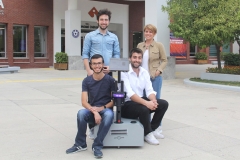
FACULTY OF ENGINEERING
Department of Electrical and Electronics Engineering
EEE 411 | Course Introduction and Application Information
| Course Name |
Control Systems
|
|
Code
|
Semester
|
Theory
(hour/week) |
Application/Lab
(hour/week) |
Local Credits
|
ECTS
|
|
EEE 411
|
Fall/Spring
|
3
|
0
|
3
|
5
|
| Prerequisites |
None
|
|||||
| Course Language |
English
|
|||||
| Course Type |
Service Course
|
|||||
| Course Level |
First Cycle
|
|||||
| Mode of Delivery | - | |||||
| Teaching Methods and Techniques of the Course | - | |||||
| Course Coordinator | ||||||
| Course Lecturer(s) | ||||||
| Assistant(s) | ||||||
| Course Objectives | The main objective of this course is to introduce the fundamental concepts feedback control and dynamical systems. The course begins with an introduction of the history of automatic control and then introduces the mathematical foundations of the system design by reviewing the Laplace transform and the solution of differential equations. State variable methods will be introduced and employed for the analysis of the feedback control systems. |
| Learning Outcomes |
The students who succeeded in this course;
|
| Course Description | Analysis and synthesis of continuous and sampleddata linear feedback control systems. Properties and advantages of feedback systems. Timedomain and frequencydomain performance measures. Stability and degree of stability. Nyquist criterion. Frequencydomain design. Root locus method. Compensation techniques. Application to a wide variety of physical systems. Some previous laboratory experience with electronic systems is assumed. Analysis and synthesis of continuous and sampleddata linear feedback control systems. Properties and advantages of feedback systems. Timedomain and frequencydomain performance measures. Stability and degree of stability. Nyquist criterion. Frequencydomain design. Root locus method. Compensation techniques. Application to a wide variety of physical systems. Some previous laboratory experience with electronic systems is assumed. |
|
|
Core Courses | |
| Major Area Courses |
X
|
|
| Supportive Courses | ||
| Media and Management Skills Courses | ||
| Transferable Skill Courses |
WEEKLY SUBJECTS AND RELATED PREPARATION STUDIES
| Week | Subjects | Related Preparation |
| 1 | Introduction to Control Systems, 1.2 Brief History of Automatic Control; 1.3 Examples of Control Systems 101.4 Engineering Design 171.5 Control System Design 181.6 Mechatronic Systems 21 | Chapter 1. Sections 16. Modern Control Systems, 12 / E, Dorf & Bishop ©2011 | Prentice Hall , ISBN10: 0136024580 | ISBN13: 9780136024583 |
| 2 | Mathematical Models of Systems2.2 Differential Equations of Physical Systems 502.3 Linear Approximations of Physical Systems 552.4 The Laplace Transform 582.5 The Transfer Function of Linear Systems 65 | Chapter 2. Sections 15. Modern Control Systems, 12 / E, Dorf & Bishop ©2011 | Prentice Hall , ISBN10: 0136024580 | ISBN13: 9780136024583 |
| 3 | Mathematical Models of Systems2.5 The Transfer Function of Linear Systems 652.6 Block Diagram Models 792.7 SignalFlow Graph Models 842.8 Design Examples 902.9 The Simulation of Systems Using Control Design Software 113 | Chapter 2. Sections 59. Modern Control Systems, 12 / E, Dorf & Bishop ©2011 | Prentice Hall , ISBN10: 0136024580 | ISBN13: 9780136024583 |
| 4 | State Variable Models 3.2 The State Variables of a Dynamic System 1623.3 The State Differential Equation 1663.4 SignalFlow Graph and Block Diagram Models 1713.5 Alternative SignalFlow Graph and Block Diagram Models 182 | Chapter 3. Sections 15. Modern Control Systems, 12 / E, Dorf & Bishop ©2011 | Prentice Hall , ISBN10: 0136024580 | ISBN13: 9780136024583 |
| 5 | State Variable Models 3.6 The Transfer Function from the State Equation 1873.7 The Time Response and the State Transition Matrix 1893.8 Design Examples 1933.9 Analysis of State Variable Models Using Control Design Software 206 | Chapter 3. Sections 69. Modern Control Systems, 12 / E, Dorf & Bishop ©2011 | Prentice Hall , ISBN10: 0136024580 | ISBN13: 9780136024583 |
| 6 | Feedback Control System Characteristics 4.2 Error Signal Analysis 2374.3 Sensitivity of Control Systems to Parameter Variations 2394.4 Disturbance Signals in a Feedback Control System 2424.5 Control of the Transient Response 2474.6 SteadyState Error 2504.7 The Cost of Feedback 2534.8 Design Examples 254 | Chapter 4. Sections 18. Modern Control Systems, 12 / E, Dorf & Bishop ©2011 | Prentice Hall , ISBN10: 0136024580 | ISBN13: 9780136024583 |
| 7 | The Performance of Feedback Control Systems 5.2 Test Input Signals 3055.3 Performance of SecondOrder Systems 3085.4 Effects of a Third Pole and a Zero on the SecondOrder System Response 3145.5 The sPlane Root Location and the Transient Response 3205.6 The SteadyState Error of Feedback Control Systems 3225.7 Performance Indices 330 | Chapter 5. Sections 17. Modern Control Systems, 12 / E, Dorf & Bishop ©2011 | Prentice Hall , ISBN10: 0136024580 | ISBN13: 9780136024583 |
| 8 | The Stability of Linear Feedback Systems 6.1 The Concept of Stability 3876.2 The Routh—Hurwitz Stability Criterion 3916.3 The Relative Stability of Feedback Control Systems 3996.4 The Stability of State Variable Systems 401 | Chapter 6. Sections 14. Modern Control Systems, 12 / E, Dorf & Bishop ©2011 | Prentice Hall , ISBN10: 0136024580 | ISBN13: 9780136024583 |
| 9 | The Root Locus Method 7.2 The Root Locus Concept 4447.3 The Root Locus Procedure 4497.4 Parameter Design by the Root Locus Method 4677.5 Sensitivity and the Root Locus 473 | Chapter 7. Sections 15. Modern Control Systems, 12 / E, Dorf & Bishop ©2011 | Prentice Hall , ISBN10: 0136024580 | ISBN13: 9780136024583 |
| 10 | The Root Locus Method 7.6 PID Controllers 4807.7 Negative Gain Root Locus 4927.8 Design Examples 4967.9 The Root Locus Using Control Design Software 510 | Chapter 7. Sections 69. Modern Control Systems, 12 / E, Dorf & Bishop ©2011 | Prentice Hall , ISBN10: 0136024580 | ISBN13: 9780136024583 |
| 11 | Frequency Response Methods 8.2 Frequency Response Plots 5568.3 Frequency Response Measurements 5778.4 Performance Specifications in the Frequency Domain 5798.5 Log Magnitude and Phase Diagrams 582 | Chapter 8. Sections 15. Modern Control Systems, 12 / E, Dorf & Bishop © 2011 | Prentice Hall , ISBN10: 0136024580 | ISBN13: 9780136024583 |
| 12 | Stability in the Frequency Domain 9.2 Mapping Contours in the sPlane 6369.3 The Nyquist Criterion 6429.4 Relative Stability and the Nyquist Criterion 6539.5 TimeDomain Performance Criteria in the Frequency Domain 6619.6 System Bandwidth 668 | Chapter 9. Sections 16. Modern Control Systems, 12 / E, Dorf & Bishop ©2011 | Prentice Hall , ISBN10: 0136024580 | ISBN13: 9780136024583 |
| 13 | The Design of Feedback Control Systems10.2 Approaches to System Design 74510.3 Cascade Compensation Networks 74710.4 PhaseLead Design Using the Bode Diagram 75110.5 PhaseLead Design Using the Root Locus 75710.6 System Design Using Integration Networks 76410.7 PhaseLag Design Using the Root Locus 76710.8 PhaseLag Design Using the Bode Diagram 77210.9 Design on the Bode Diagram Using Analytical Methods 776 | Chapter 10. Sections 19. Modern Control Systems, 12 / E, Dorf & Bishop ©2011 | Prentice Hall , ISBN10: 0136024580 | ISBN13: 9780136024583 |
| 14 | Design of State Variable Feedback Systems11.2 Controllability and Observability 83511.3 FullState Feedback Control Design 84111.4 Observer Design 84711.5 Integrated FullState Feedback and Observer 85111.6 Reference Inputs 85711.7 Optimal Control Systems 85911.8 Internal Model Design 869 | Chapter 11. Sections 18. Modern Control Systems, 12/E, Dorf & Bishop ©2011 | Prentice Hall , ISBN10: 0136024580 | ISBN13: 9780136024583 |
| 15 | Digital Control Systems13.2 Digital Computer Control System Applications 98513.3 SampledData Systems 98713.4 The zTransform 99013.5 ClosedLoop Feedback SampledData Systems 99513.6 Performance of a SampledData, SecondOrder System 999 | Chapter 13. Sections 13.113.6. Modern Control Systems, 12 / E, Dorf & Bishop ©2011 | Prentice Hall , ISBN10: 0136024580 | ISBN13: 9780136024583 |
| 16 | Digital Control Systems13.7 ClosedLoop Systems with Digital Computer Compensation 100113.8 The Root Locus of Digital Control Systems 100413.9 Implementation of Digital Controllers 100813.10 Design Examples 100913.11 Digital Control Systems Using Control Design Software 101813.12 Sequential Design Example: Disk Drive Read System 1023 | Chapter 13. Sections 13.713. Modern Control Systems, 12 / E, Dorf & Bishop ©2011 | Prentice Hall , ISBN10: 0136024580 | ISBN13: 9780136024583 |
| Course Notes/Textbooks | Modern Control Systems, 12 / E, Dorf & Bishop ©2011 | Prentice Hall , ISBN10: 0136024580 | ISBN13: 9780136024583 |
| Suggested Readings/Materials | Modern Control Engineering, 5 / E, Ogata, ©2010, Prentice Hall, Published: 08/25/2009, ISBN10: 0136156738 | ISBN13: 9780136156734Control System Design, 1 / E, Goodwin, Graebe & Salgado, ©2001, Prentice Hall, Published: 09/26/2000 ISBN10: 0139586539, ISBN13: 9780139586538Feedback Control Systems, 4 / E, Phillips & Harbor©2000, Prentice Hall, Published: 08/09/1999, ISBN10: 0139490906, ISBN13: 9780139490903 |
EVALUATION SYSTEM
| Semester Activities | Number | Weigthing |
| Participation | ||
| Laboratory / Application |
5
|
25
|
| Field Work | ||
| Quizzes / Studio Critiques | ||
| Portfolio | ||
| Homework / Assignments | ||
| Presentation / Jury | ||
| Project | ||
| Seminar / Workshop | ||
| Oral Exams | ||
| Midterm |
1
|
25
|
| Final Exam |
1
|
50
|
| Total |
| Weighting of Semester Activities on the Final Grade |
7
|
70
|
| Weighting of End-of-Semester Activities on the Final Grade |
1
|
30
|
| Total |
ECTS / WORKLOAD TABLE
| Semester Activities | Number | Duration (Hours) | Workload |
|---|---|---|---|
| Theoretical Course Hours (Including exam week: 16 x total hours) |
16
|
2
|
32
|
| Laboratory / Application Hours (Including exam week: '.16.' x total hours) |
16
|
2
|
32
|
| Study Hours Out of Class |
16
|
2
|
32
|
| Field Work |
0
|
||
| Quizzes / Studio Critiques |
15
|
0
|
|
| Portfolio |
0
|
||
| Homework / Assignments |
0
|
||
| Presentation / Jury |
0
|
||
| Project |
0
|
||
| Seminar / Workshop |
0
|
||
| Oral Exam |
0
|
||
| Midterms |
1
|
0
|
|
| Final Exam |
1
|
25
|
25
|
| Total |
121
|
COURSE LEARNING OUTCOMES AND PROGRAM QUALIFICATIONS RELATIONSHIP
|
#
|
Program Competencies/Outcomes |
* Contribution Level
|
||||
|
1
|
2
|
3
|
4
|
5
|
||
| 1 | To have adequate knowledge in Mathematics, Science and Electrical and Electronics Engineering; to be able to use theoretical and applied information in these areas on complex engineering problems. |
X | ||||
| 2 | To be able to identify, define, formulate, and solve complex Electrical and Electronics Engineering problems; to be able to select and apply proper analysis and modeling methods for this purpose. |
X | ||||
| 3 | To be able to design a complex system, process, device or product under realistic constraints and conditions, in such a way as to meet the requirements; to be able to apply modern design methods for this purpose. |
X | ||||
| 4 | To be able to devise, select, and use modern techniques and tools needed for analysis and solution of complex problems in Electrical and Electronics Engineering applications; uses computer and information technologies effectively. |
X | ||||
| 5 | To be able to design and conduct experiments, gather data, analyze and interpret results for investigating complex engineering problems or Electrical and Electronics Engineering research topics. |
X | ||||
| 6 | To be able to work efficiently in Electrical and Electronics Engineering disciplinary and multi-disciplinary teams; to be able to work individually. |
X | ||||
| 7 | To be able to communicate effectively in Turkish, both orally and in writing; to be able to author and comprehend written reports, to be able to prepare design and implementation reports, to present effectively, to be able to give and receive clear and comprehensible instructions. |
|||||
| 8 | To have knowledge about global and social impact of engineering practices on health, environment, and safety; to have knowledge about contemporary issues as they pertain to Electrical and Electronics Engineering; to be aware of the legal ramifications of Electrical and Electronics Engineering solutions. |
|||||
| 9 | To be aware of ethical behavior, professional and ethical responsibility; to have knowledge about standards utilized in engineering applications
|
X | ||||
| 10 | To have knowledge about industrial practices such as project management, risk management, and change management; to have awareness of entrepreneurship and innovation; to have knowledge about sustainable development. |
|||||
| 11 | To be able to collect data in the area of Electrical and Electronics Engineering, and to be able to communicate with colleagues in a foreign language. ("European Language Portfolio Global Scale", Level B1) |
X | ||||
| 12 | To be able to speak a second foreign language at a medium level of fluency efficiently. |
|||||
| 13 | To recognize the need for lifelong learning; to be able to access information, to be able to stay current with developments in science and technology; to be able to relate the knowledge accumulated throughout the human history to Electrical and Electronics Engineering. |
X | ||||
*1 Lowest, 2 Low, 3 Average, 4 High, 5 Highest
NEWS |ALL NEWS

Life-saving projects
Students of Izmir University of Economics (IUE) took action in response to the increase in natural disasters such as earthquakes, floods and

IUE Professor elected as a ‘president’
Prof. Dr. Aydın Akan, Head of the Department of Electrical and Electronics Engineering at Izmir University of Economics (IEU), who was featured

IUE academics among the world's top 2% scientists
4 professors from Izmir University of Economics (IUE) were included in the 'World's Most Influential Scientists List' announced by a special research

One of 132 successful women in Europe
Assoc. Prof. Dr. Pınar Oğuz Ekim, Lecturer at Izmir University of Economics (IUE), was awarded a 75 thousand Euro grant from the

Academic-student partnership brought another award
Assoc. Prof. Dr. Pınar Oğuz Ekim, Faculty Member, Izmir University of Economics (IUE) came second in Turkey in the innovation and technology

Made it among the most influential scientists in the world
Three professors from Izmir University of Economics (IUE) were included in the “World's Most Influential Scientists List”, announced by a special research

Academic-student partnership brought success
Assoc. Prof. Dr. Pınar Oğuz Ekim, faculty member at Izmir University of Economics (IUE), has been shown among the top 5 successful

3 friends are on their way to Italy
Three students of Izmir University of Economics (IUE) achieved great success by being accepted to Polytechnic University of Milan, which is known
